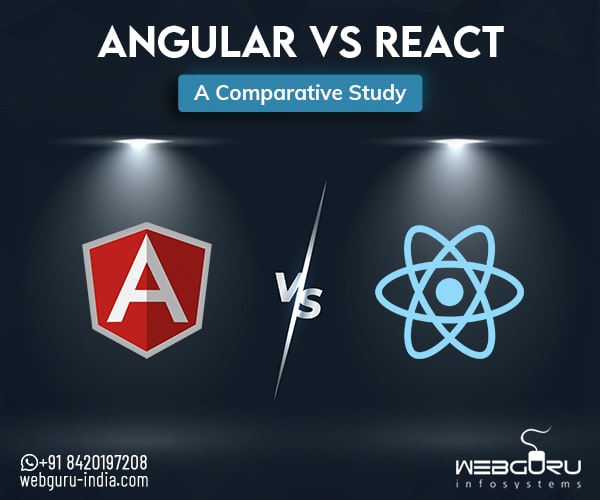Home Blog Web Application Development Angular vs React – A Comparative Study
Angular vs React – A Comparative Study
- 10 Nov / 2020
- 3,072 views

The choice of the tech stack is a determining factor for the competence of a web application. With wisely chosen tools, web development is cakewalk while a poor choice of technology can entirely mess it up.
Selecting the right front-end development framework can be a bit daunting. Each framework has its own share of pros and cons and a detailed insight is crucial to pick the right technology. Today, we are here with a competitive study between two popular JS frameworks Angular and React. We have segmented the point of comparison on three sections. We will compare the technical aspects of both the frameworks and the developers’ way around the framework. Keep reading to learn all about it.
Technical Aspect
- Architecture
Though both React and Angular are considered as front-end JS frameworks, there’s a minor difference. React is basically a JavaScript library with only view mode. On the other hand, Angular is a full-fledged framework with an MVC architecture. This makes Angular an end-to-end development framework that need not rely on external 3rd party libraries.
Angular comes with its own set of features and doesn’t require the developers to integrate new libraries for extending the features. React requires React Native – a cross-platform app development framework. It requires an integration with diverse libraries to enable an app-building capability. Angular is more of a one-size-fits-all platform for the experts of web application development services to craft stunning and user-friendly front-end interfaces.
- Data Binding
Angular has a two-way data binding approach. It automatically changes the model state whenever any change is made in the UI element. On the other hand, React library has a one-way approach. This is effective for projects with massive amounts of coding.
However, some developers possess a different notion. According to them, though one-way or unidirectional data binding (of React) can render apps to be more stable and it is easier for debugging, the two-way or bidirectional data-binding (of Angular) is simpler to work with. Therefore, as you can see, there is no clear cut winner in this.
- DOM
DOM or Document Object Management organizes the HTML and XML documents in the manner of a tree. It is a crucial metric for the evaluation of the frameworks’ performance. Angular uses a real DOM. This means that the whole tree structure is redefined when a single change occurs. This can make the process slower.
React, on the other hand, uses virtual DOM. It allows the developers to execute changes to the tree without having to update the entire tree.
- Modularity and Re-Usability
In order to slack some of the development cost, businesses prefer to craft efficient web apps with reliable re-usable components. It also reduces the developers’ efforts and saves time while ensuring a faster rollout of the app to the market.
Both React and Angular have component-based architecture. It implies that any app developed with these frameworks will consist of the modular components. These components can be reused and combined to craft new interface features. This is a much-desired property in modern front-end development activities. Both React and Angular allow the developers to scale applications with reusable components that don’t need to be built every time from scratch.
- Maintainability of Code
Angular is popular for developing a single-page application. That’s because single-page apps have a complex structure and multiple programming modules. Maintaining the complex structure while keeping the application rich is quite tricky for the developers. It demands selecting a framework that actively allows complex maintainability. Angular resolves the problem by crafting maintainable JS. It provides HTML extension to deal with the issues.
- Server Rendering
Angular facilitates the web crawlers by producing a static version of the web apps that are easily searchable. By using server-side rendering, Angular renders the apps by creating a static view before it becomes interactive. The developers need to cleverly use the combination of client-side caching and JSON in order to increase the server-side performance. Angular is also equipped with the in-built testing features like mocking the objects and dependency injection. It is also capable of reducing the amounts of codes by eliminating the requirement of compiling and reflecting the modifications in the frontend.
In order to make a web app SEO-proof, it’s important to render the app to the server. React has some specific functionalities to execute it with ease. It is known as RenderToString function. The developers can also use RenderToStaticMarkup to avoid creating DOM attributes like data-react-id. It is useful for creating a simple and static page generator.
- Optimizing the Bundle File
Angular uses a compiler that adds to the understanding between a code written in the bundle file and the browser. It speeds up the compilation process of the browser. Bundle size matters to a great extent while working with React. It’s important to constantly monitor the file size as the growth of a business leads to the addition of new features.
- Update
Upgrades allow a framework to add new elements to a web app and power it up. Angular rolls out one major update at an interval of six months and offers a depreciation period of another six months for a new release. The framework is equipped with separate bundled offerings so the update process is quite easy.
Developers’ Way Around the Framework
- Learning Curve
Mastering any of the frameworks requires dedication and passion. That both the frameworks have a great market and people are always on a lookout to hire Angular developers or React developers encourage the trainees.
Angular is a dynamic framework. It includes various elements like modules, components, directives, services, dependency injections, services and more. React also requires the potential developers to manage internal states, write components, use props for configuration.
Once the developers learn the primary things of Angular and React, learning the minute details of both the frameworks is a fun and rewarding experience.
- Ease of Development
Though both Angular and React are JS based frameworks, Angular is built with TypeScript. TypeScript is a large superset of JavaSript that is used for crafting large and complex web apps. It offers improved navigation, autocomplete capability and faster code refactoring once compared to pure JS. On the other hand, React uses JS ES6+ and JSX script that is a simpler UI code extension.
Final Take
Comparing Angular and React is like comparing apples and oranges. Both frameworks have their own set of brilliance and limitations. So, if you are not sure whether to engage Angular or React development services to craft an industry-standard web app, you can talk to the professionals and learn which one is better for your specific project.

Surajit Das
Surajit Das has vast experience in web app development. His expertise in various programming languages & frameworks is reflected in the blogs.
3 comments
Leave a Reply

-
1000+
Happy
Clients -
25+
Countries
Served -
19+
Years of
Trust







Informative Post
Angular and ReactJS is a very competitive field and both requires study hard to achieve good numbrers.
I would personally say angular has a steep learning curve compared to react. Thank you for this amazing share